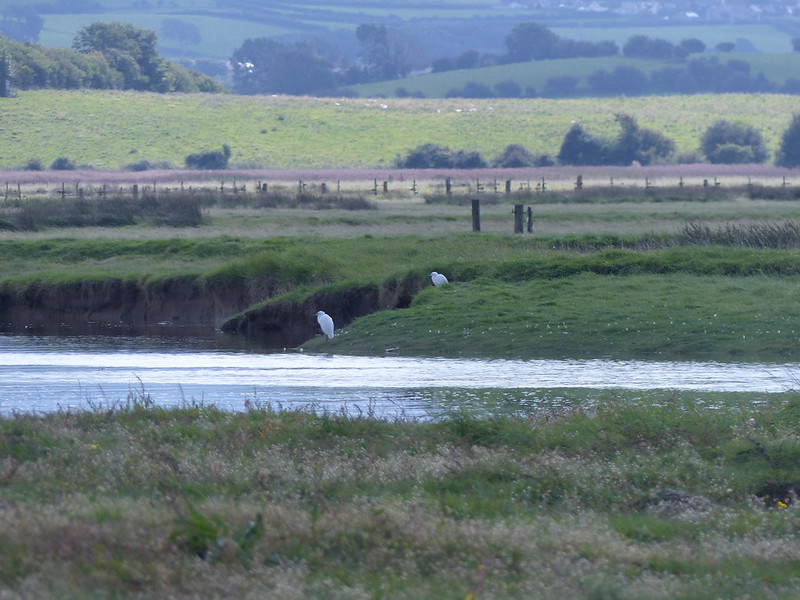
A final walk, and post, from last August.
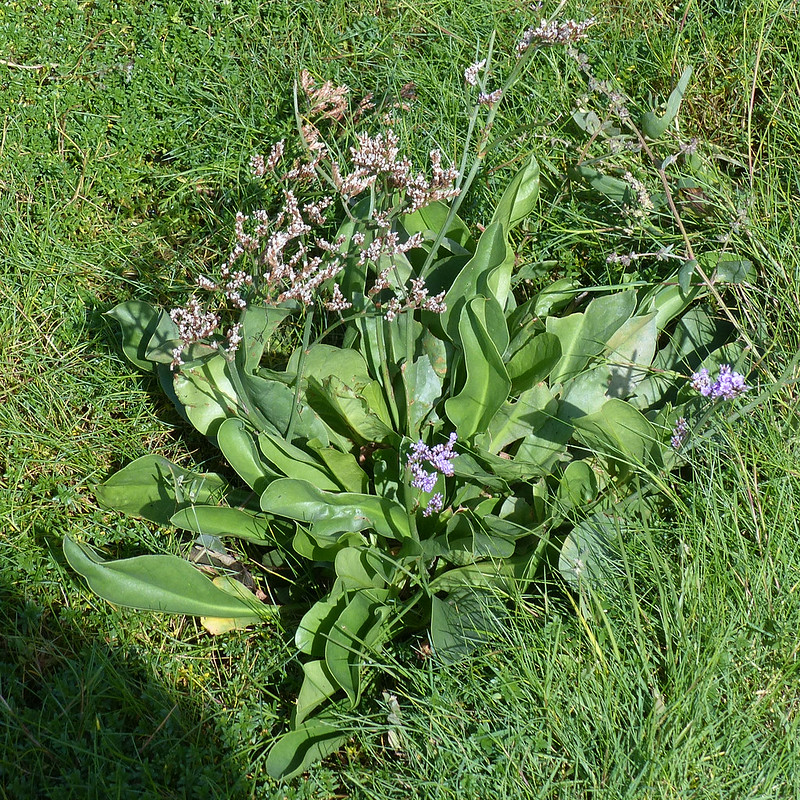
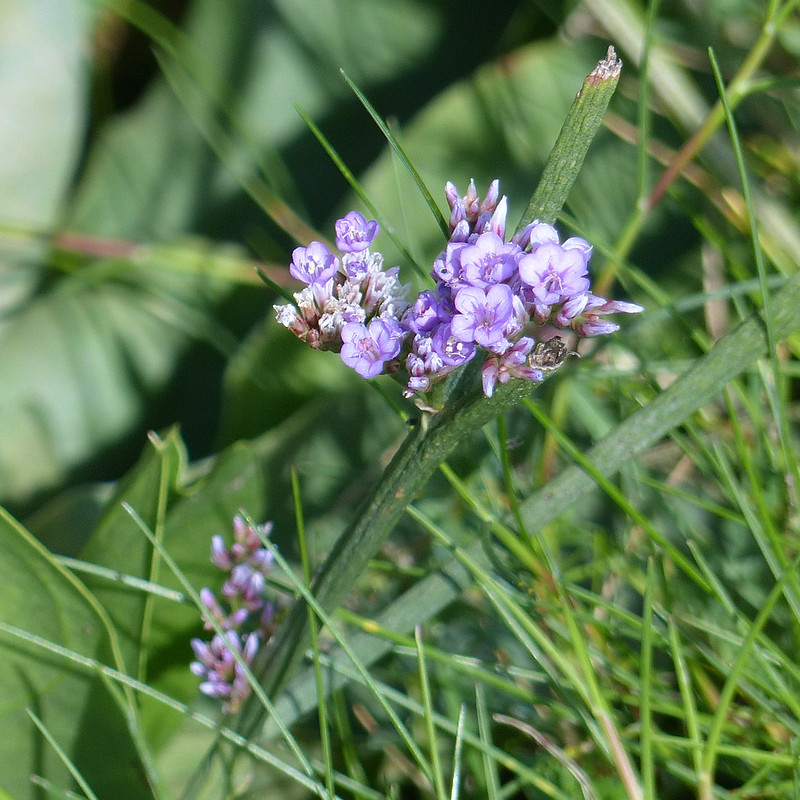
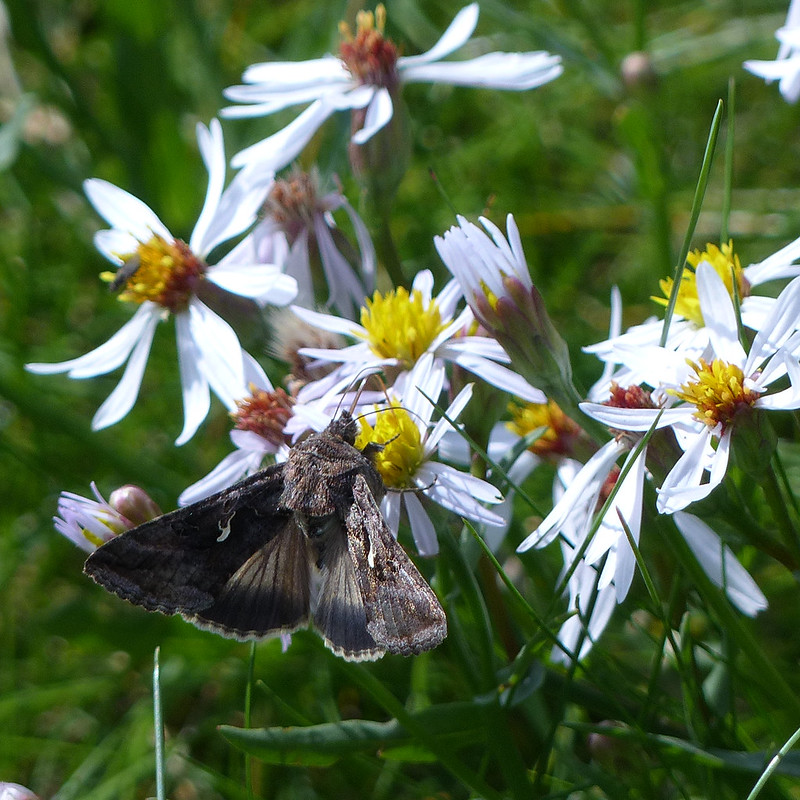
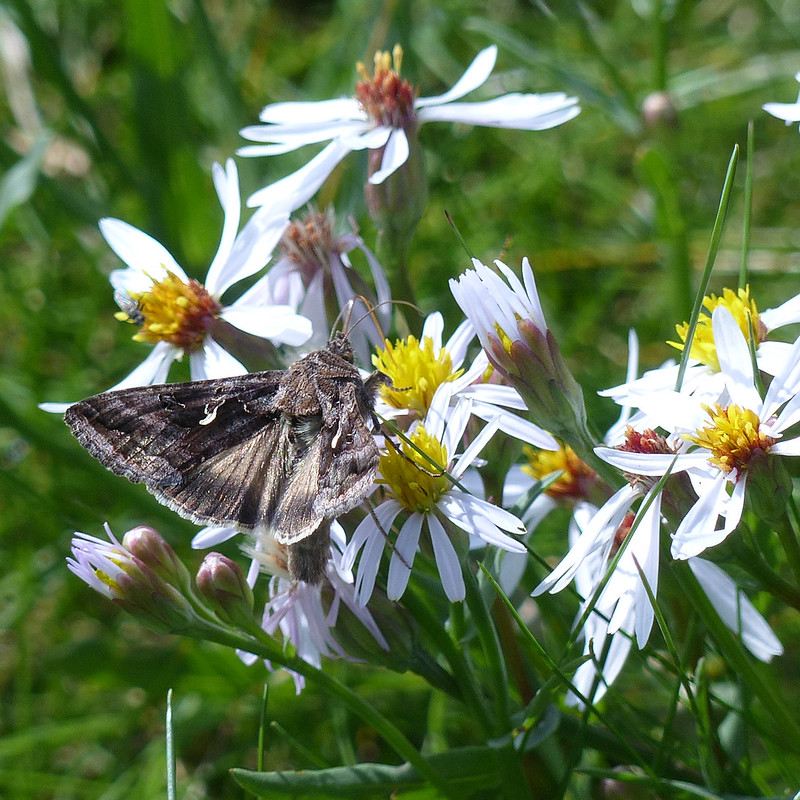
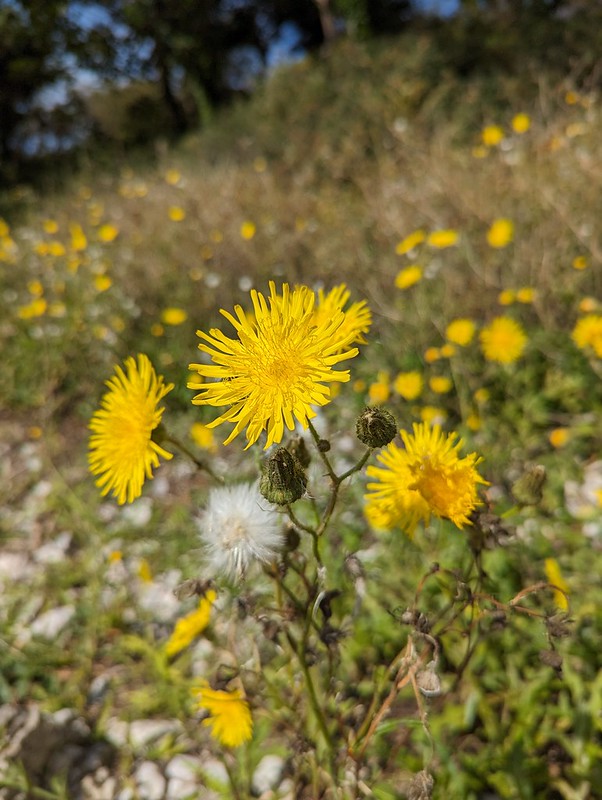
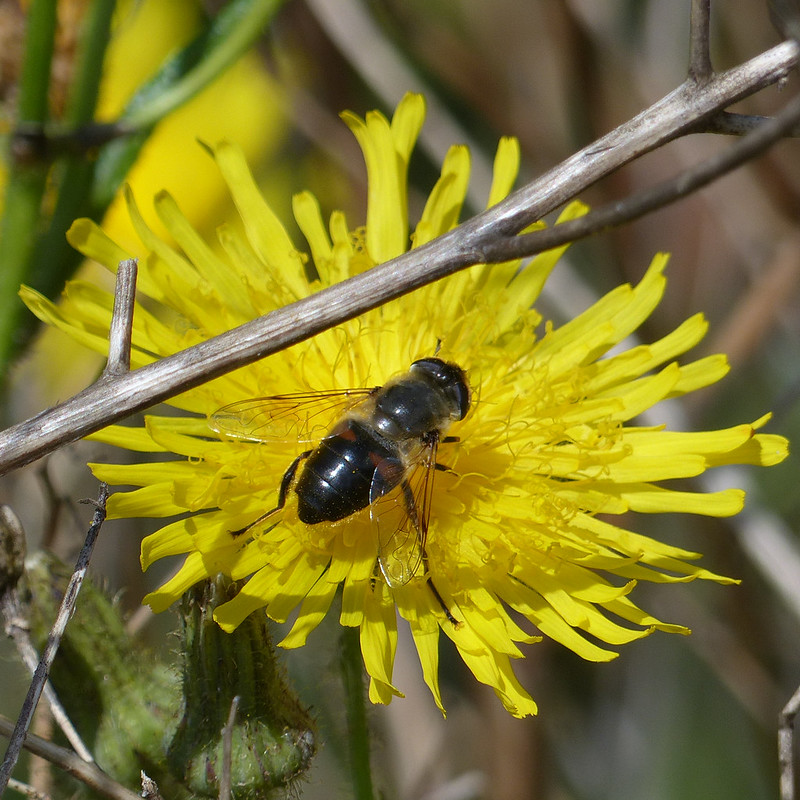
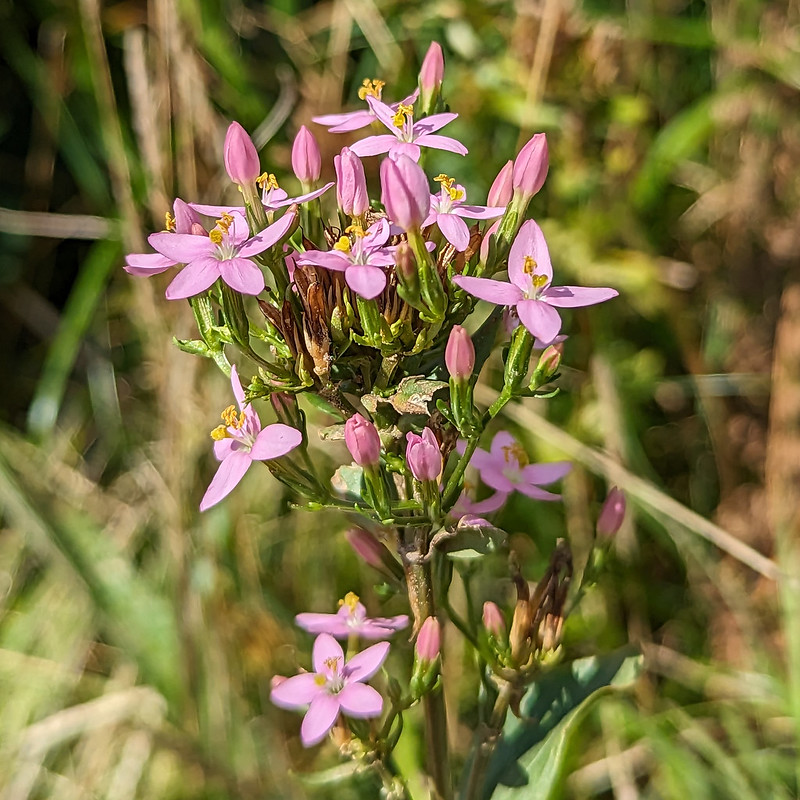

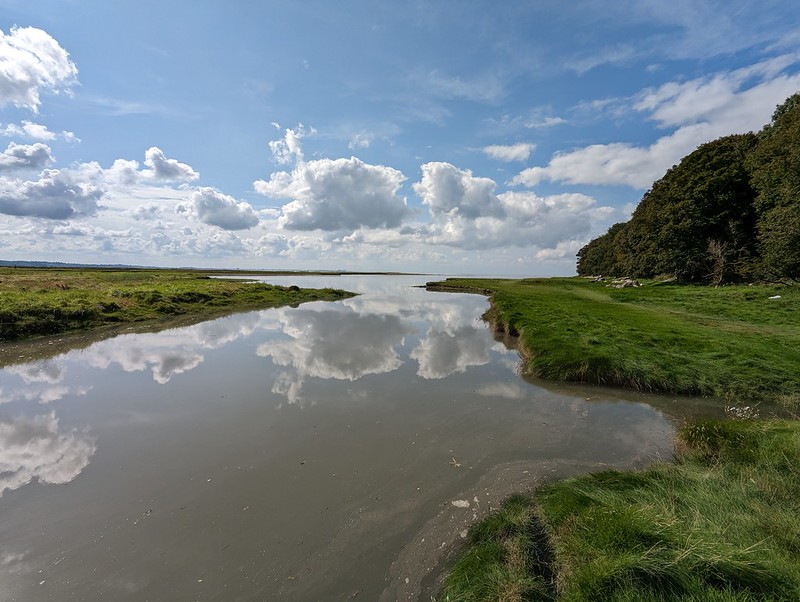
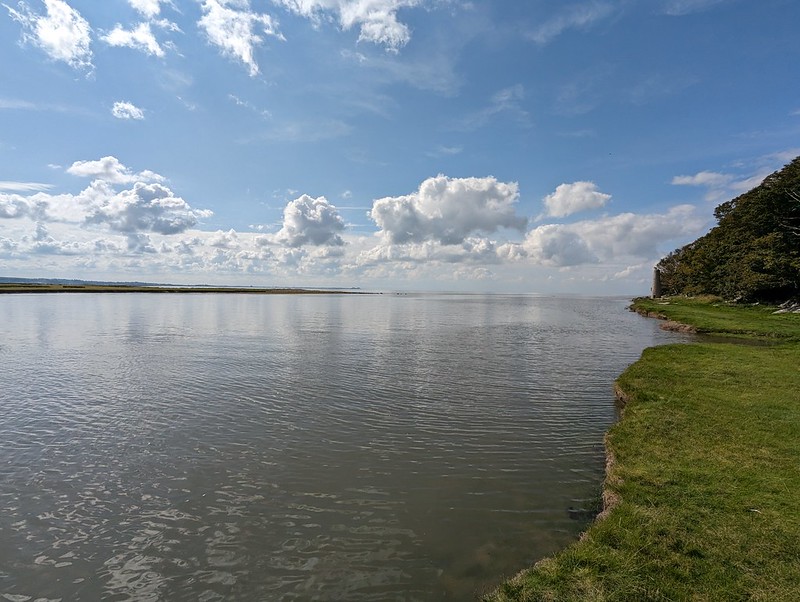

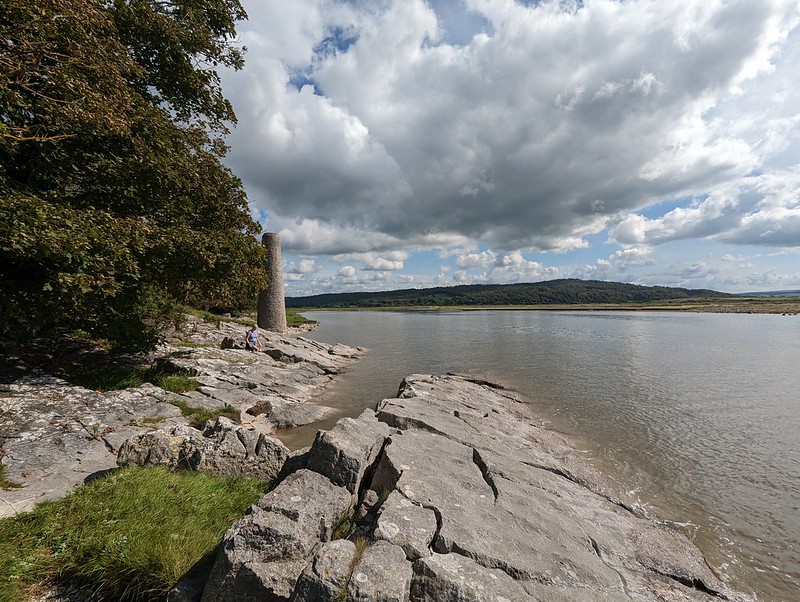
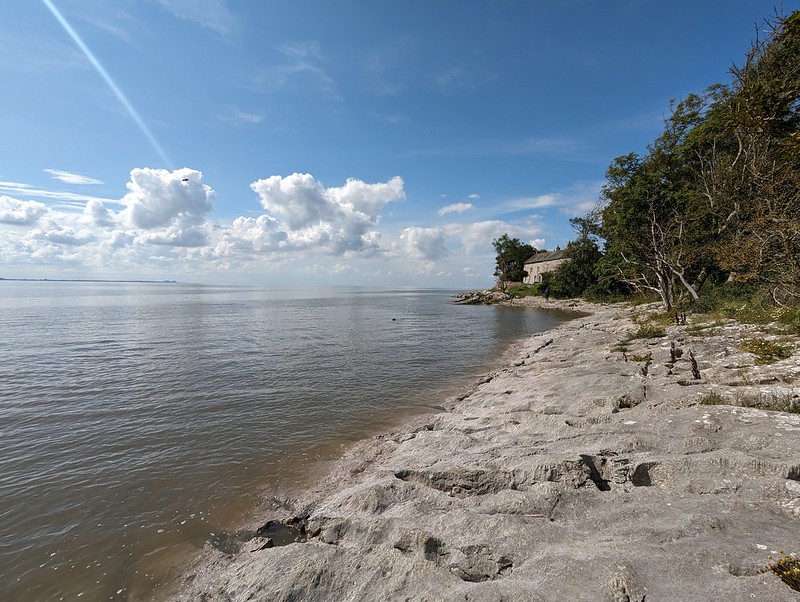
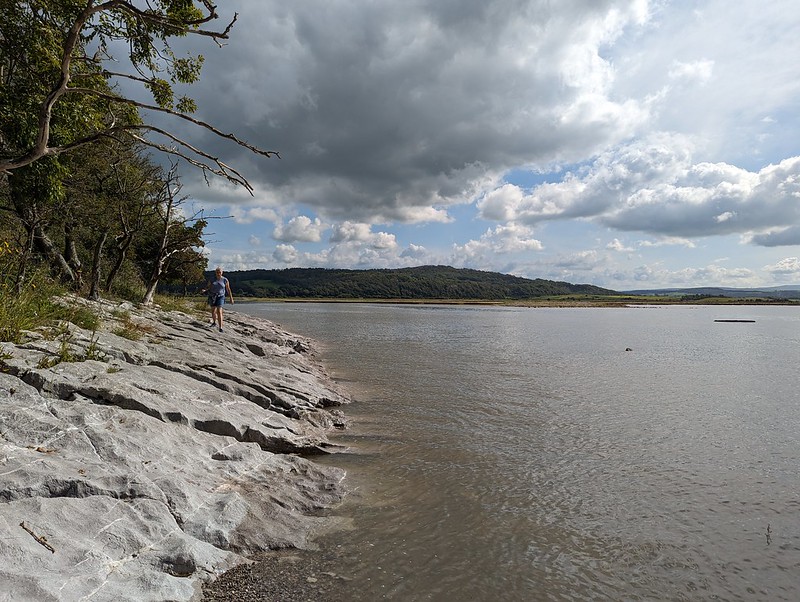
Moving on to September next…

A final walk, and post, from last August.














Moving on to September next…

I’ve always considered the view from Monsal Head of the Headstone Viaduct to be one of the iconic scenes in the Peak District. Since the days when I was a regular visitor to the area, the old railway line has been converted into a walking and cycling track, a fact which Andy alerted me to on his blog.
We’d brought the DBs bikes with us, and hired bikes at Hassop Station for TBH and myself. I remember that my bike was a Raleigh, but not which model, which is a shame, because it was very comfortable and a pleasure to ride.
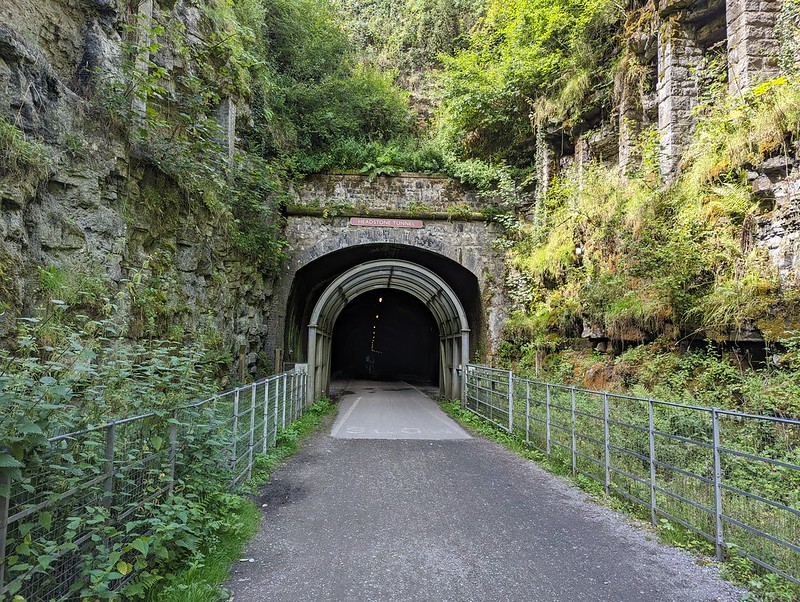
Hassop is near, but not at, one end of the line. We set-off west to tackle the larger portion of the trail first. There are six tunnels on the route and I seem to have taken photos either of, or in, most of them. I’m not sure why I was so chuffed to be cycling through tunnels, perhaps because I’m still essentially a big kid at heart.

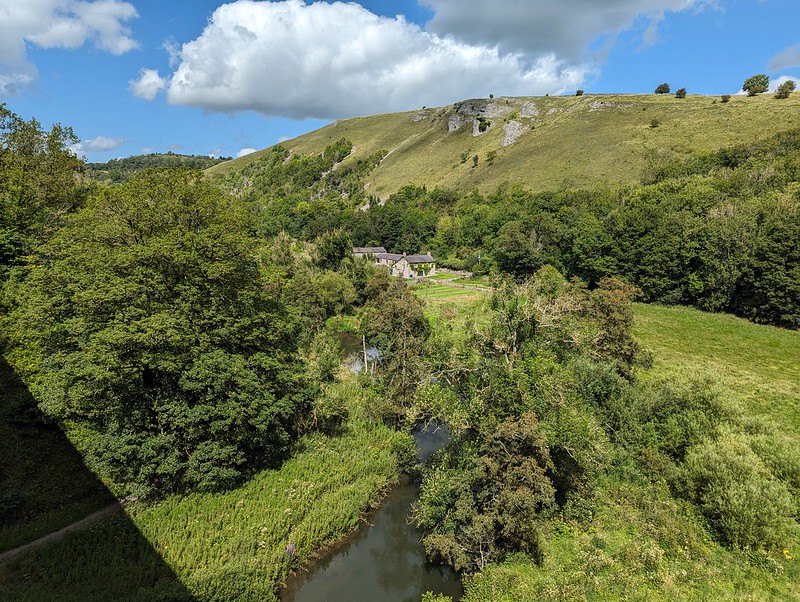
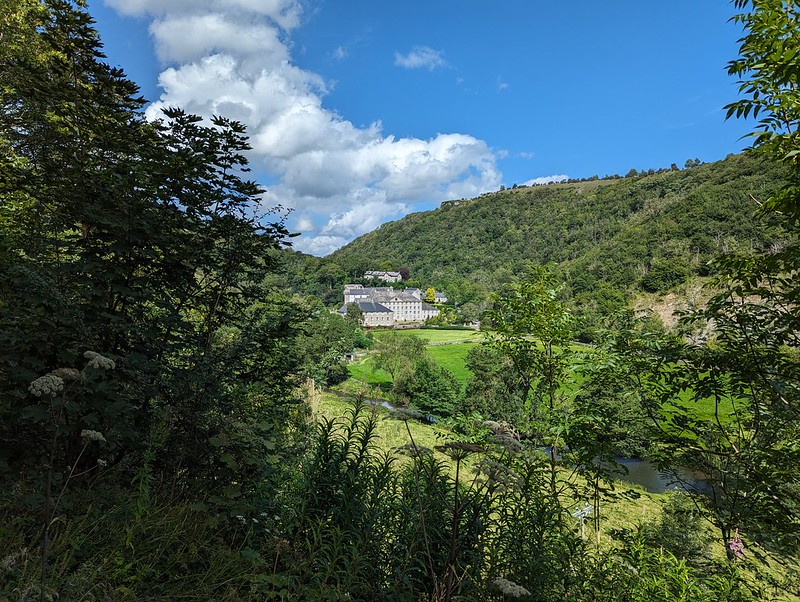


The trail generally follows the valley of the River Wye, but, confusingly, the name of the dale changes along its length: Monsal Dale, Water-cum-Jolly Dale, Millers Dale, Chee Dale, Wye Dale. It’s hard to know where the transitions occur and also hard to remember where each of the photos was taken, so I can’t say which dale each one shows!
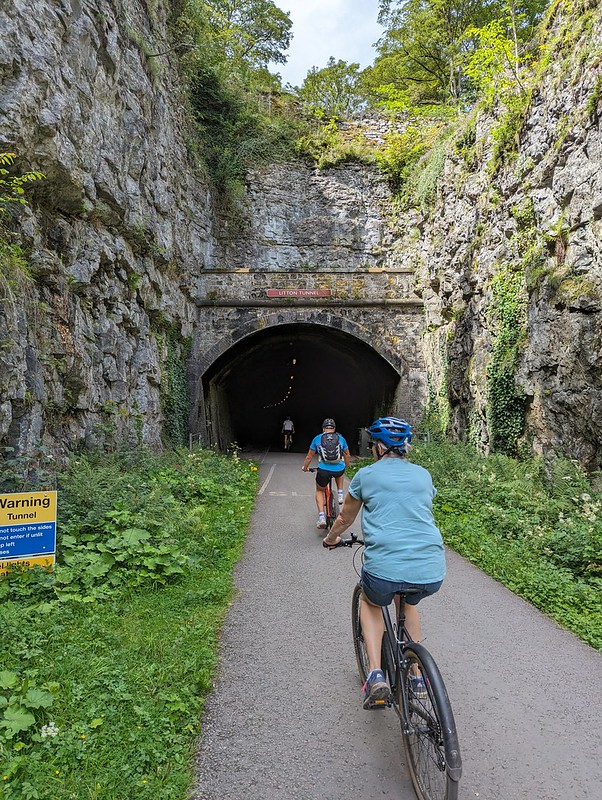
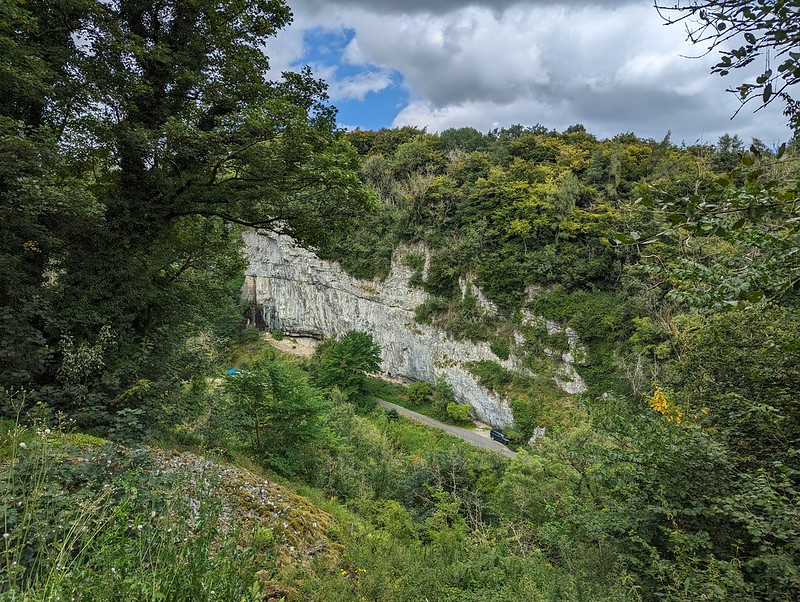

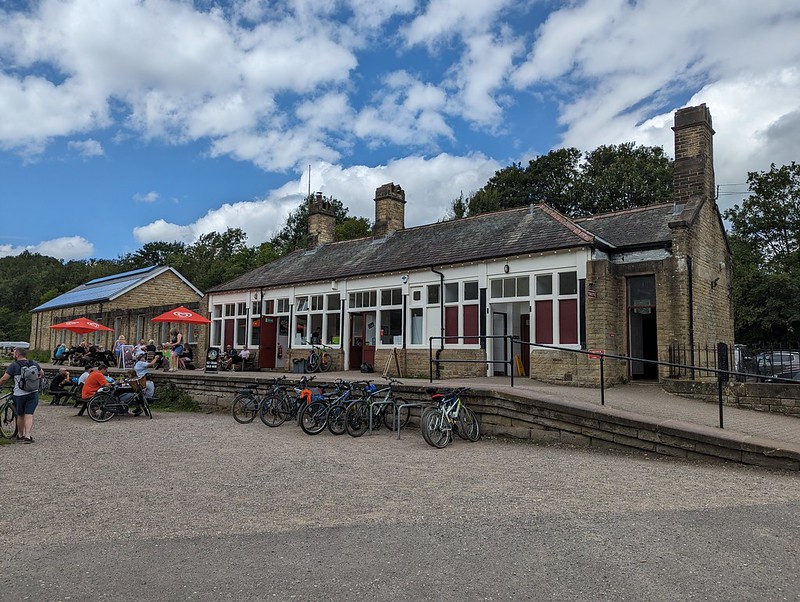
The cafe at Millers Dale station was popular and we probably should have got some lunch there. Little S did get an ice-cream, which for some reason seems to have caused some consternation on his part…
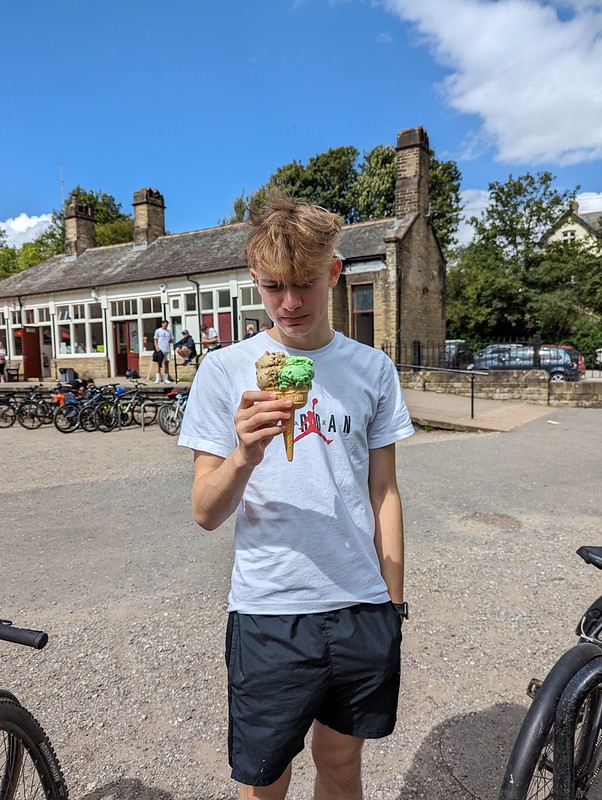


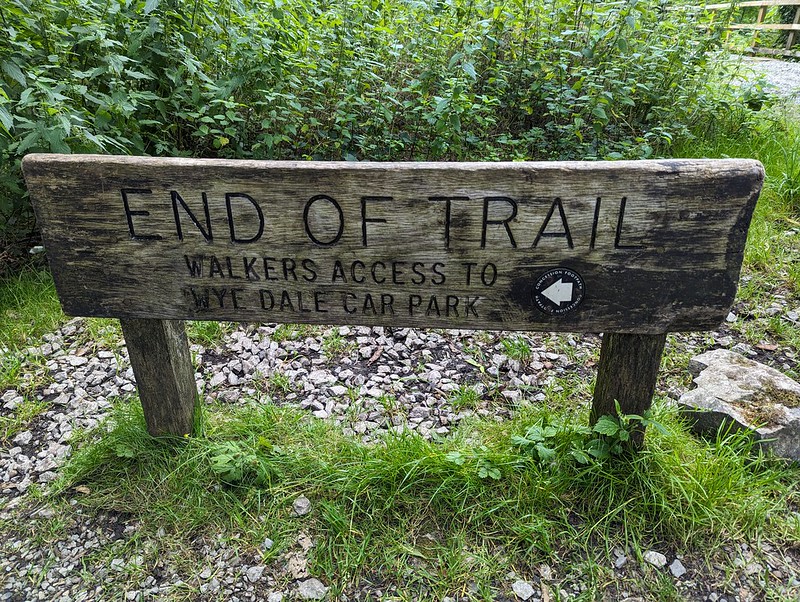
We’d been planning to eat at the cafe at Blackwell Mill, at the western end of the trail, but didn’t, I think it was closed. Either that, or it didn’t have any vegan options, I can’t remember.

I’d chosen to start near the Bakewell end because I’d read online that it would be uphill from there. It must be a very gentle gradient: it hadn’t seemed uphill, but now that we turned around, the difference was really obvious and going the other way was much faster and could be free-wheeled.
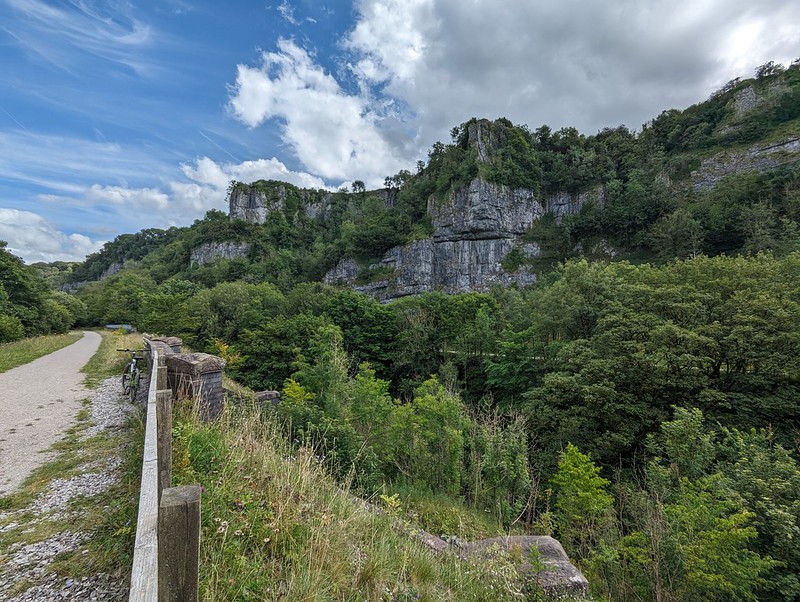
I had noticed a short spur here coming post and took a detour now to have a nose. It was well worth it for the view.
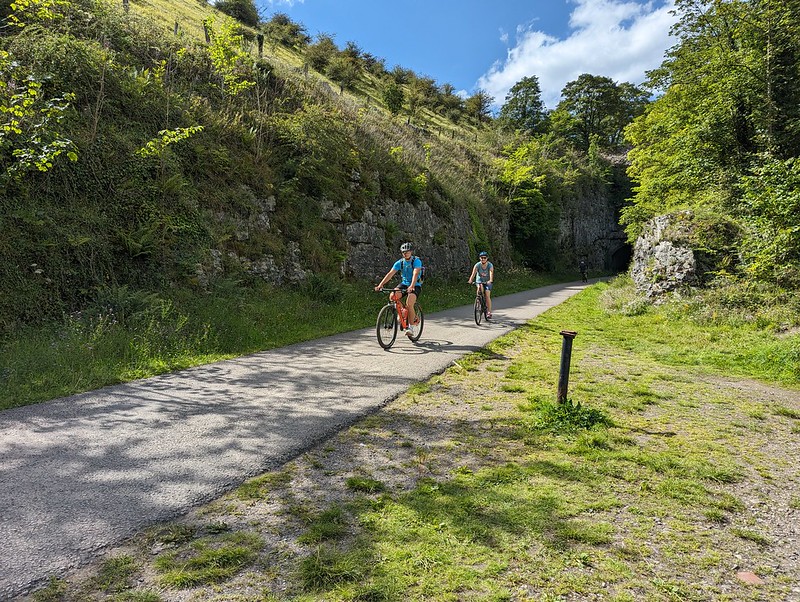

Back at Hassop station we had a very late lunch in the excellent cafe there, which is highly recommended.
We were running short of time on our bike rentals, so I asked in the shop whether we were okay to cycle to the other end of the line near Bakewell. I was told that it was fine, so long as we were back before closing, but that the return part was uphill and that many people found it challenging.


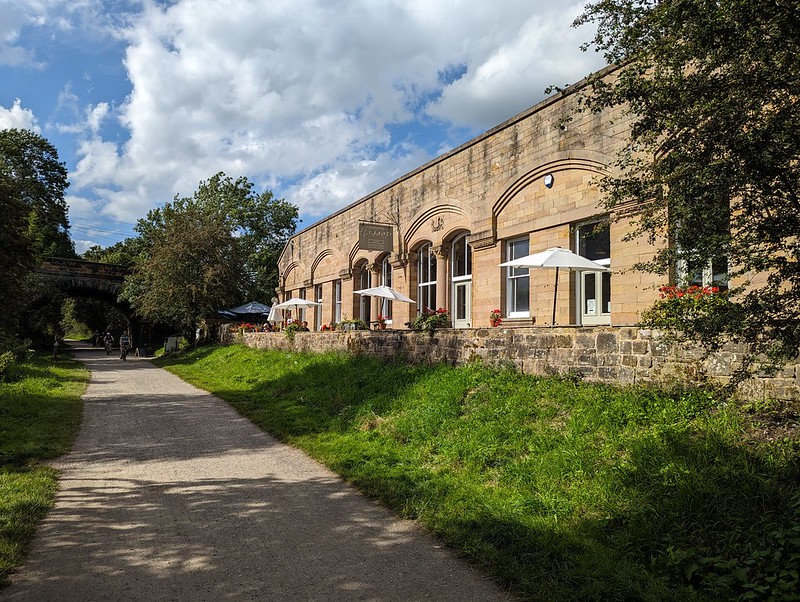
Actually, it was fine and I’m pleased that we managed to fit in the entire route. I was hoping for a view over Bakewell, but whilst we did get some, they were partial and didn’t yield very good photos.
The whole trail is 8½ miles, so there and back is only 17, not a very long cycle ride I know, but immensely enjoyable and pretty much flat which is a big selling point as far as I’m concerned.
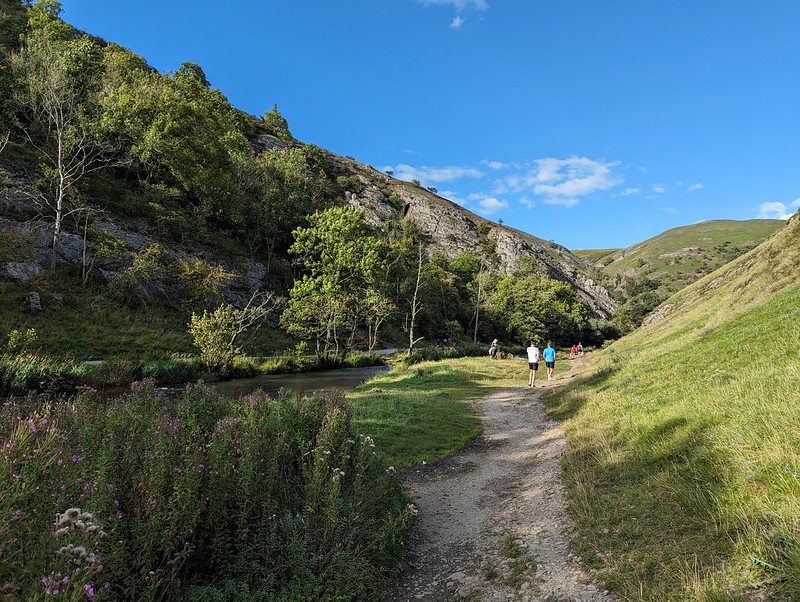
From my childhood visits to the Peak District I think three memories stand out: the show caves around Castleton; steaming, overheated cars pulled over on the roadside up Winnats Pass; and the stepping stones and rock scenery of Dove Dale. Since Dove Dale wasn’t far from where we staying, I was determined to fit in a visit whilst we were there and although it was late in the day, we managed to get into the National Trust car park before the entrance was closed for the evening.
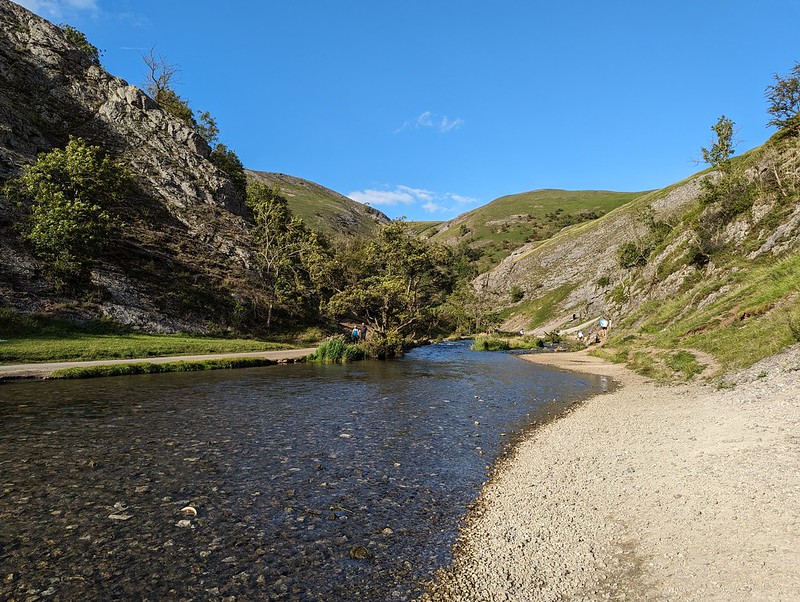
Even though it was early evening, the area around the stepping stones was still very busy, with lots of large family groups enjoying picnics.
We didn’t have to go far though before it became much quieter.

I remember, on those early visits, being awed by the natural rock arch above the path, and that it was close to Reynard’s Cave, but I don’t think we ever climbed up to the arch or the cave.

Judging by the heavily eroded path, that’s now a very popular activity. It’s pretty steep, more so than this photo suggests.
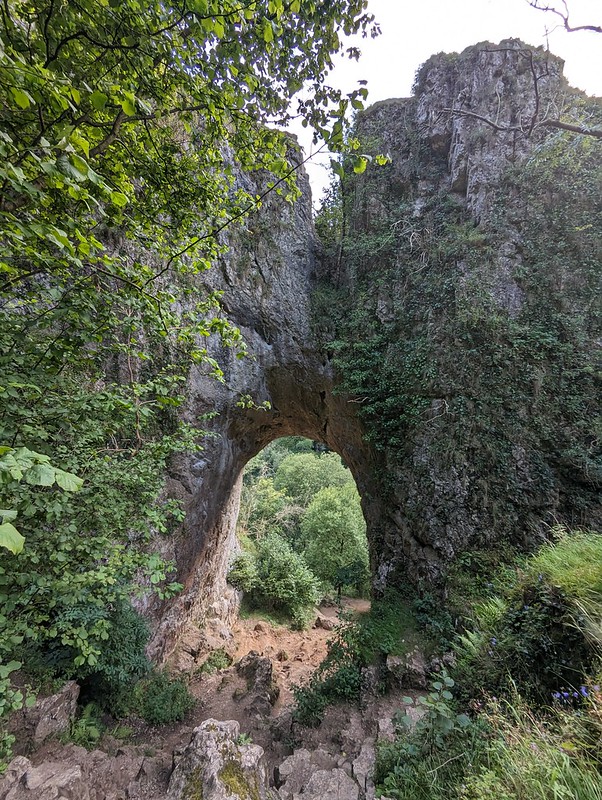
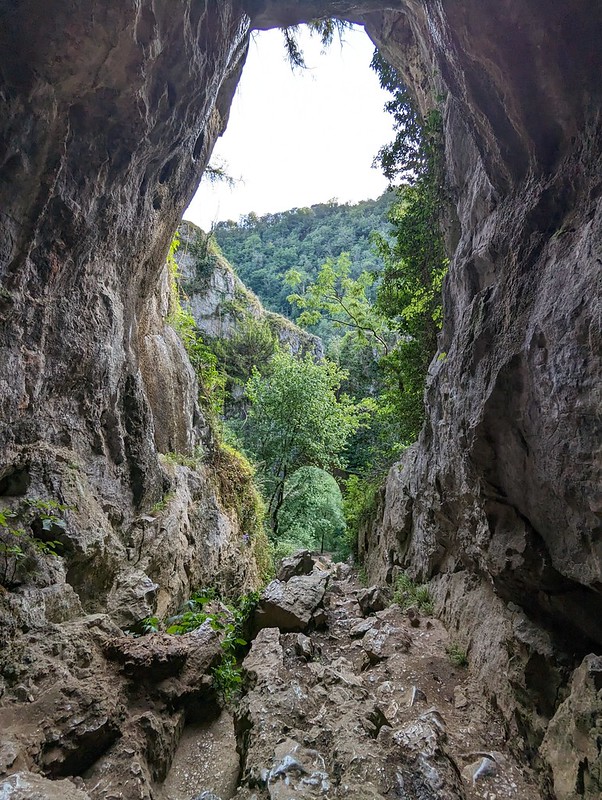

Like Thor’s Cave, there’s archeological evidence showing that Reynard’s Cave was occupied, at least sporadically, during the Neolithic through to the Medieval period.

We found another, smaller cave just around the corner from Reynard’s and then an alternative route back to the river which was a little less steep.

Before heading for home we walked a little further upstream so that the DBs could investigate this rather wet cave which had a stream flowing out of it…
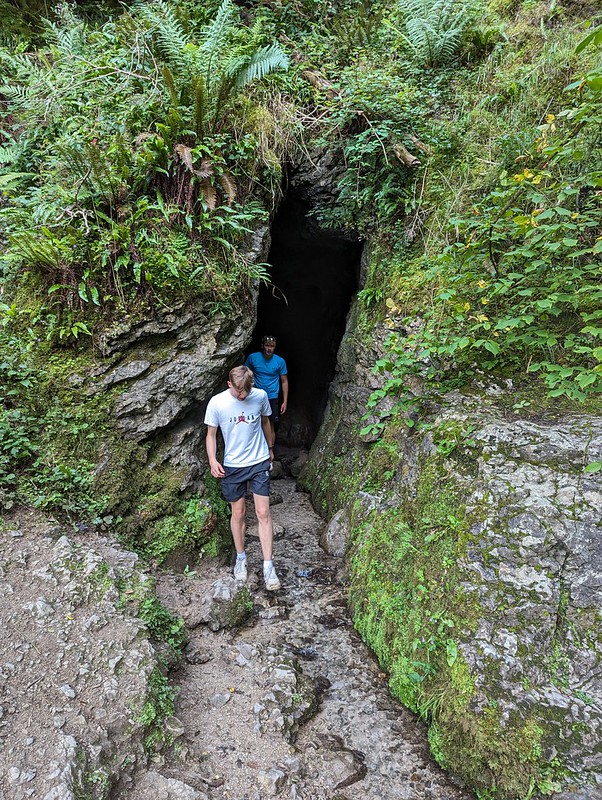
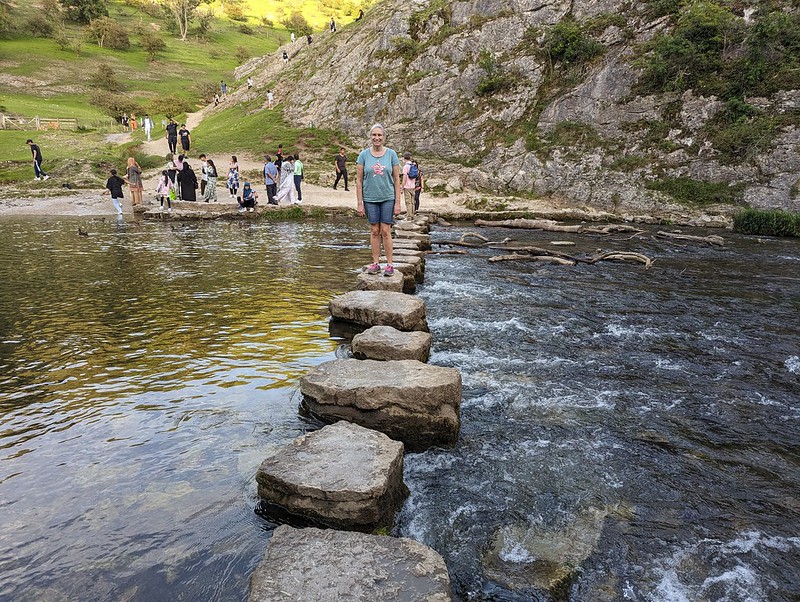
And finally, on the path back to the car park, a couple of interesting insect encounters…

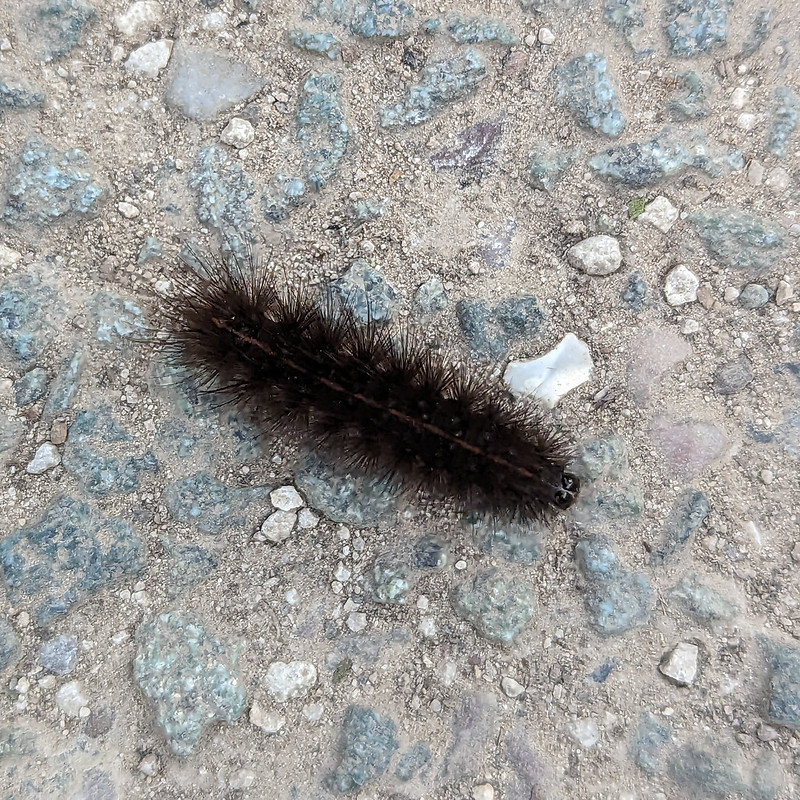
This was the last full day of our flying visit to the Midlands. Our trip was short, but packed with interest and I hope it’s not too long before we’re back in the area.
Monday
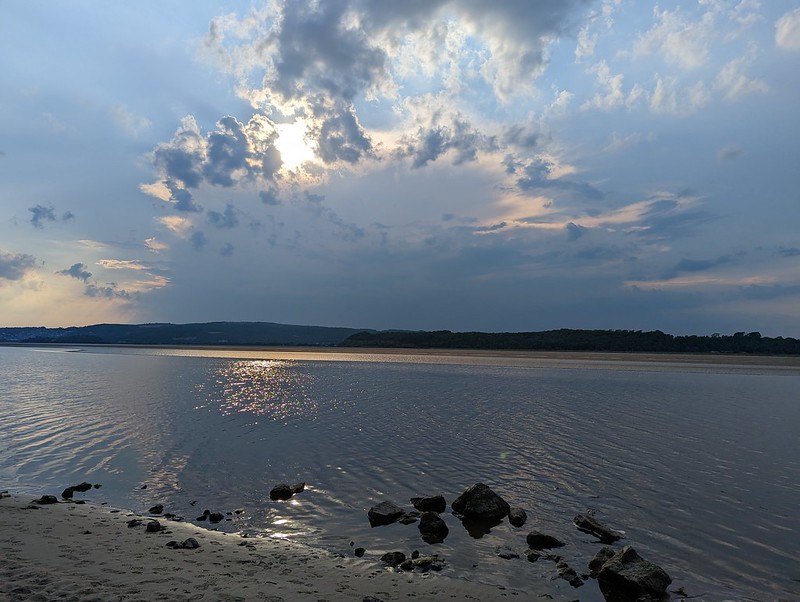
Another week’s worth of evening strolls, from mid-June and a week when, unusually, I managed to get out every day, although most of the walks were quite short.
The exception was on the Monday evening: B and A, his girlfriend, wanted to walk her dog around the coast to Arnside. I drove his car to Arnside, so that they could drive back, and did the same walk in reverse.

It was a beautiful evening, warm and sunny. There were lots of other people out walking and a fair few swimming in the river. But there was what looked like a huge storm, roughly, I would guess, over the Coniston Fells, giving some dramatic skies.
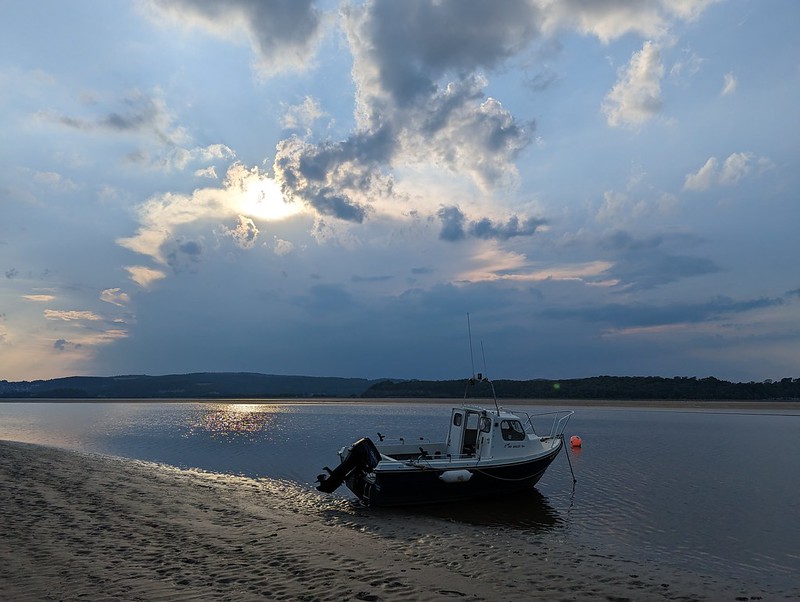


I hadn’t walked all that far before I bumped into B and A, who had set-off much earlier.

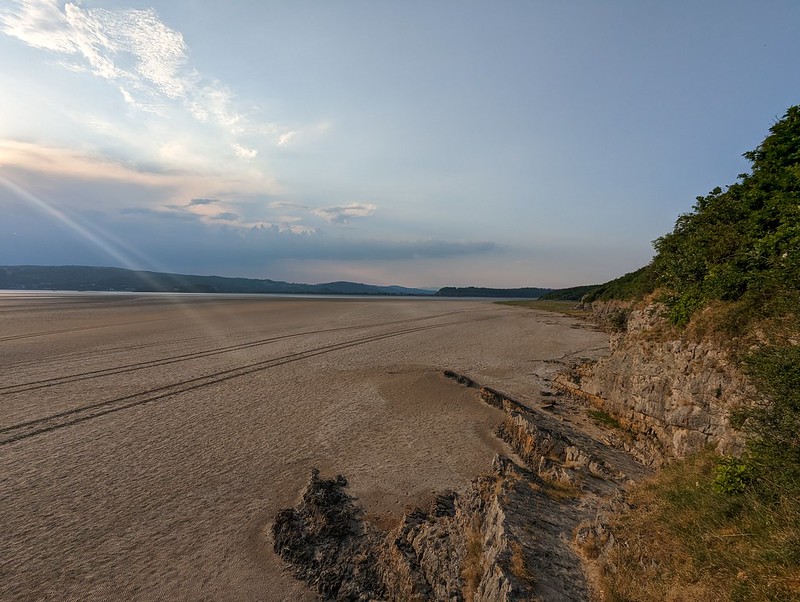

I was taking photos of the late evening light on the Bell Heather when this Six-spot Burnet Moth appeared, apparently from within the heather. I was slightly frustrated that I hadn’t brought my camera when I spotted what I think was a female Black-tailed Skimmer Dragonfly on a tree above the cliff-top path.
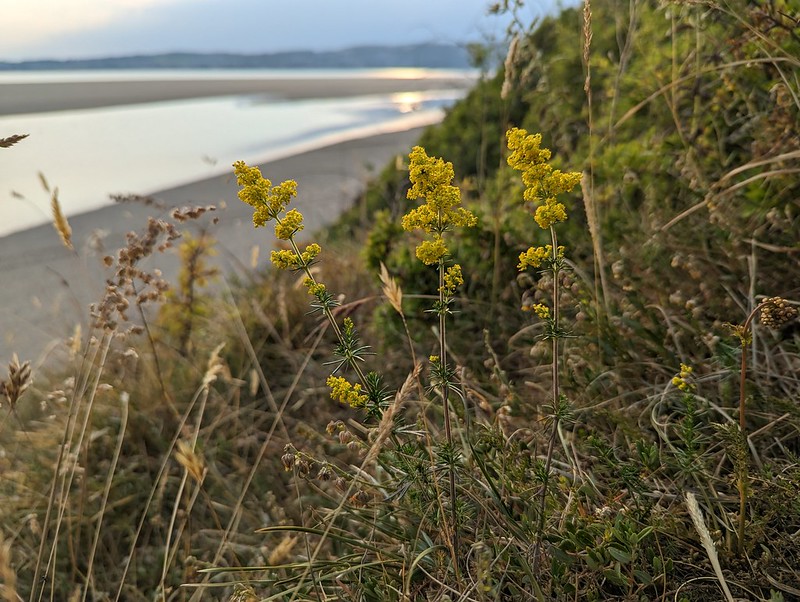


I found an area on the cliffs which was covered with Bloody Crane’s-bill plants; it’s a shame I didn’t stumble across them when they were all flowering. The photo does show where the name ‘Crane’s-bill’ originates – with the shape of the long thin seeds. This is a geranium, Geranium sanguineum, and the genus’ name, geranium, also derives from the Greek word for crane.
Tuesday

How many times have I walked past this magnificent tree, and I’m still not sure which kind of Lime it is, but I’m beginning to think that it’s a Common Lime, a natural hybrid of Small-leaved and Large-leaved Limes.

Wednesday

Thursday

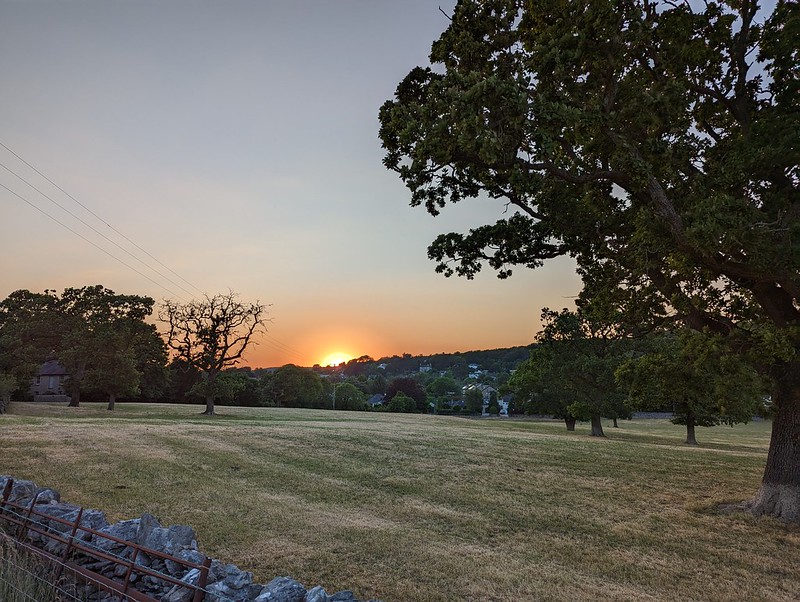
Friday
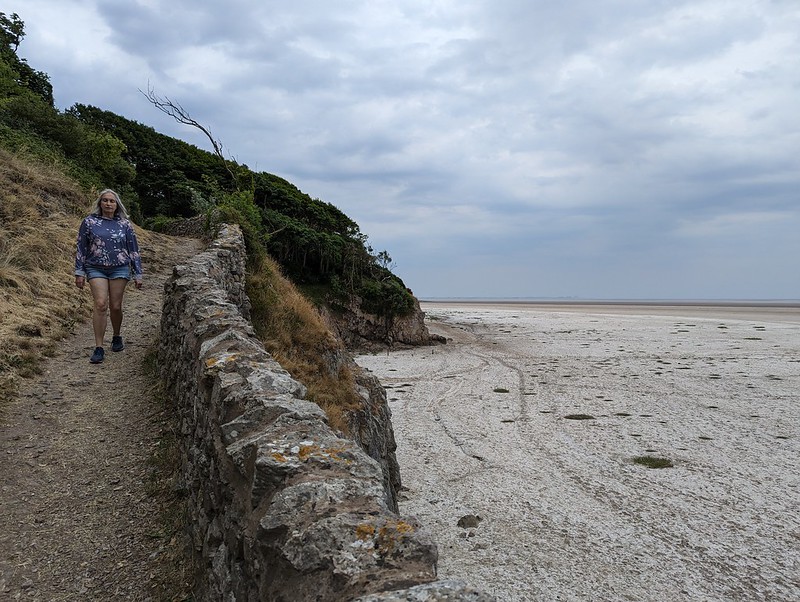
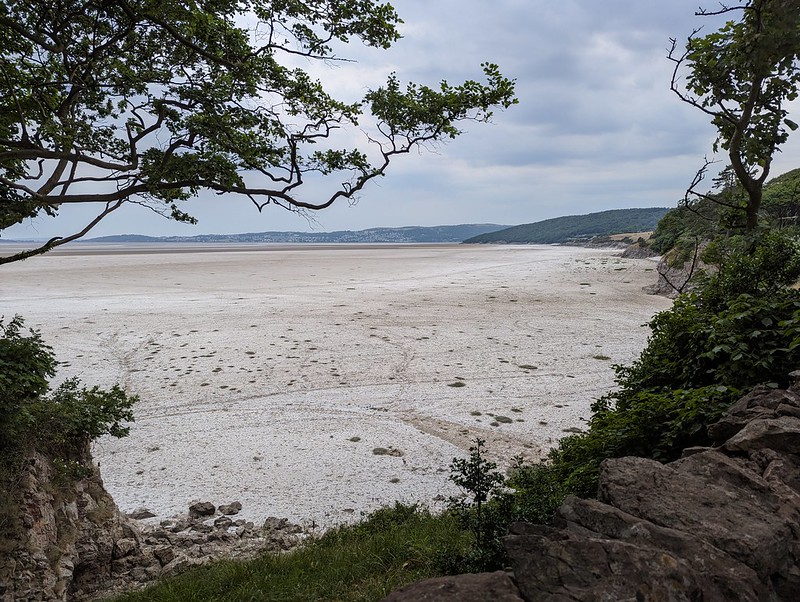
The post’s title is stolen from an Elvis Costello song, whom I’ve been listening to a fair bit recently.
“Welcome to the working week,
Oh, I know it don’t thrill you, I hope it don’t kill you,
Welcome to the working week,
You got to do it till you’re through it so you better get to it.”
I’m back to work on Monday. Can’t wait.
Silverdale Green – Clark’s Lot – Hollin’s Lane – Fleagarth Wood – Quaker’s Stang – Cragfoot – Crag Road – Occupation Road – Warton Crag – Occupation Road – Coach Road – Peter Lane – Summer House Hill – Leighton Hall – Grizedale Farm – Leighton Moss – Golf Course – The Row – Hagg Wood

Another local training walk. Another glorious spring day. It was a cracking walk – and I have not much else to say about it.

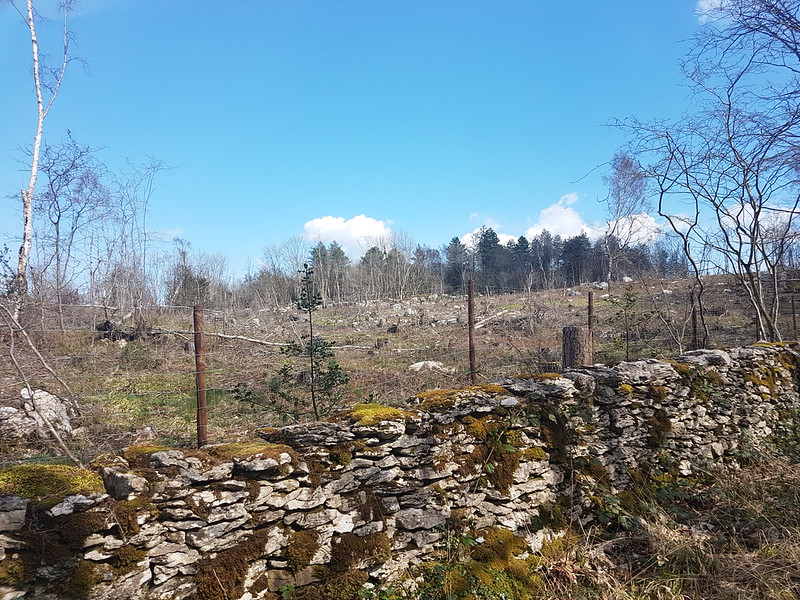


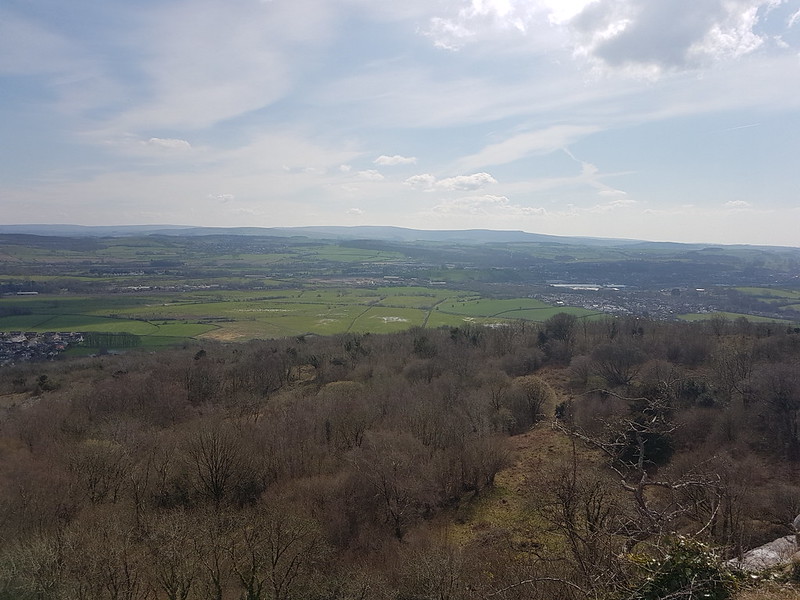
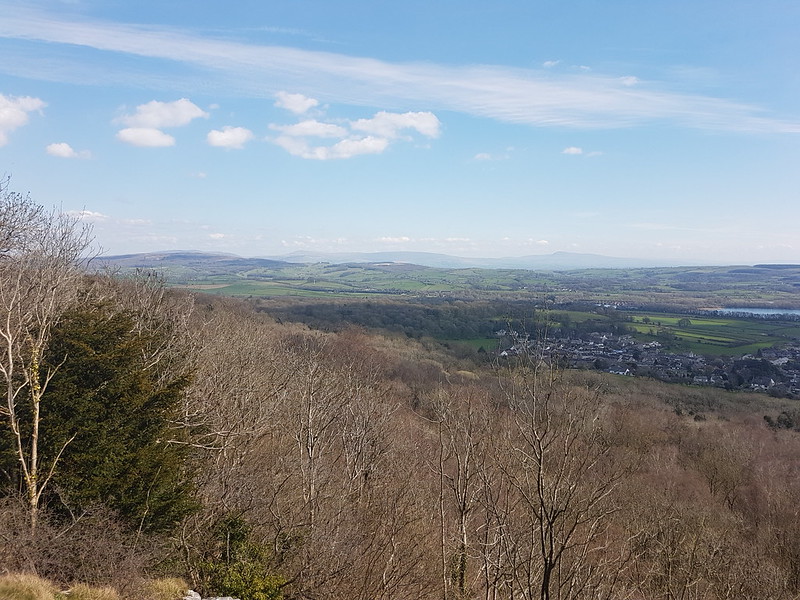

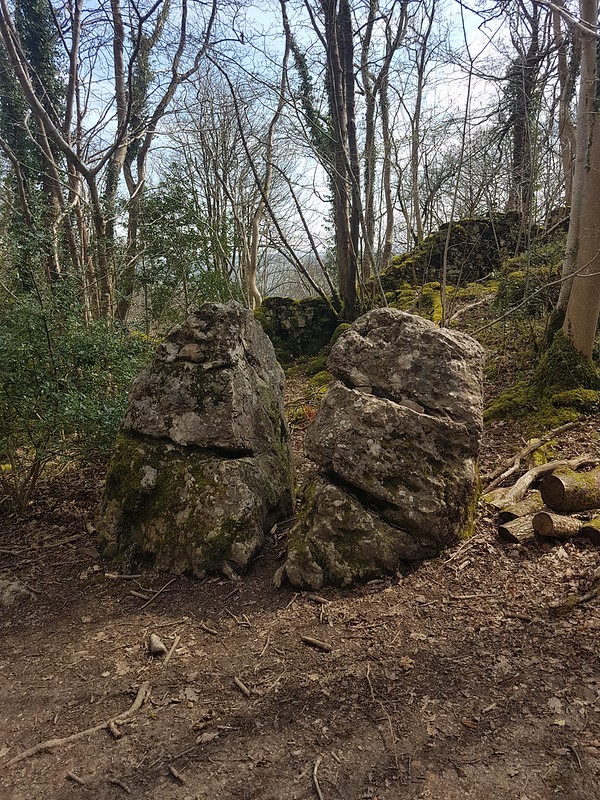
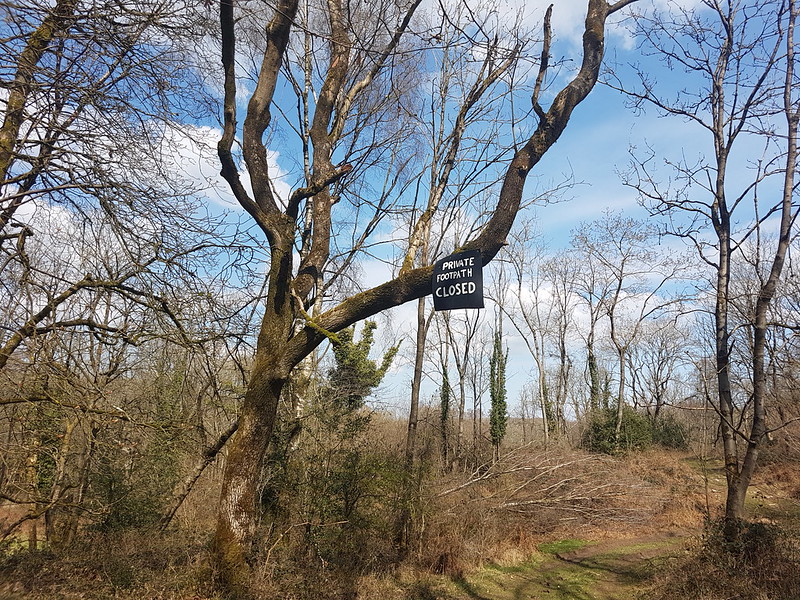
This former path us to cut a corner between Occupation Road (a track) and Coach Road, out of Warton. It was a lovely route, and also gave access to The Three Brothers, some very large limestone boulders which the kids used to enjoy clambering about on. It’s very sad that we’re not allowed this way anymore.




Another Sunday, another training walk. We decided to make this one a local wander. I think TBH had requested something quite lengthy, which I had dually planned, but then forestalled that plan by heading out for an early run, so that we eventually cut our walk a little shorter to compensate.
Anyway – we walked around the coast to Arnside, but then not back over the Knott (shock, horror), but rather continued along the river to Storth and back via Hazelslack, Leighton Beck Bridge and Hawes Water. In all, 11¾ miles, according to MapMyWalk at least.
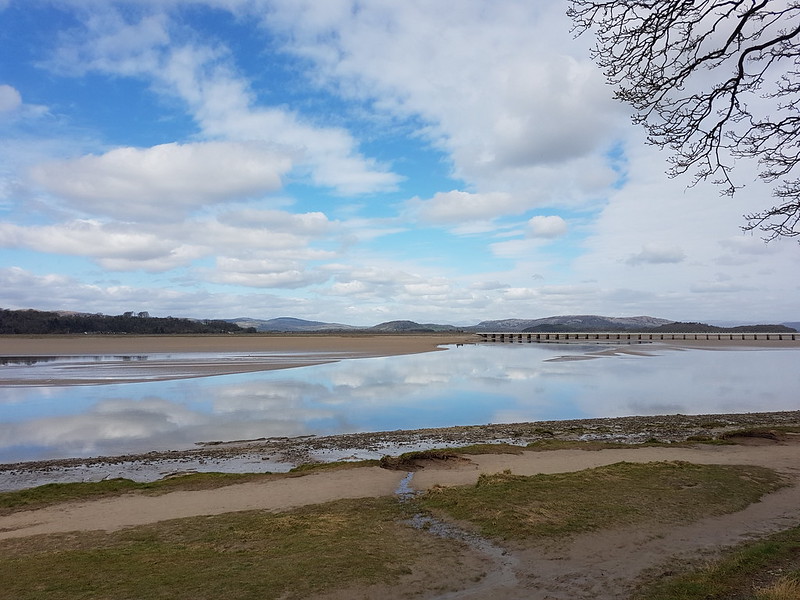
You can probably tell from the first photo, with TBH in several layers and gloves, that with the day starting overcast, it wasn’t particularly warm, but as we walked around the coast a few patches of blue began to appear and eventually it turned into a warm and sunny day, so that we were both a bit over-dressed.
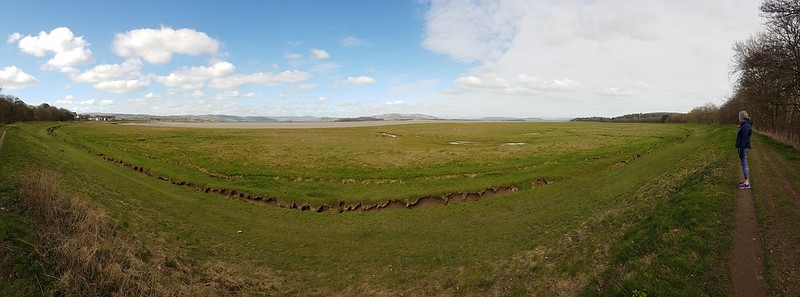
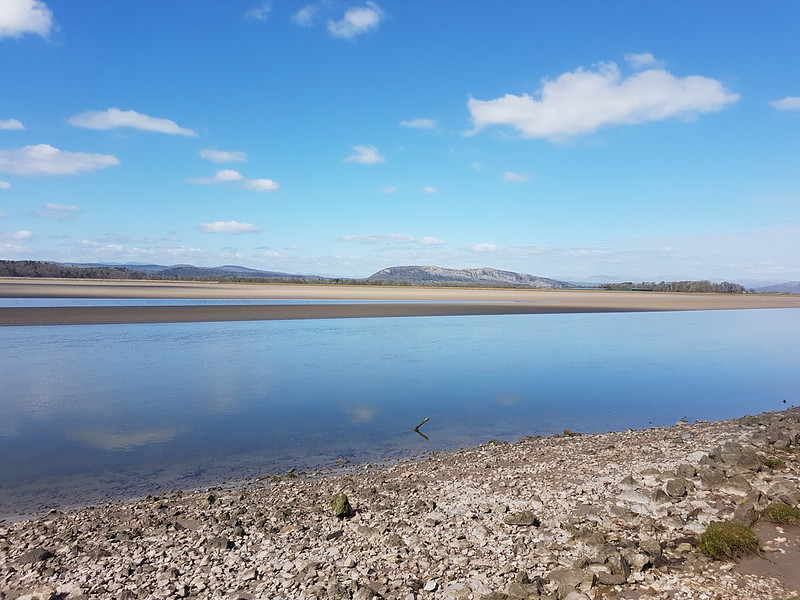
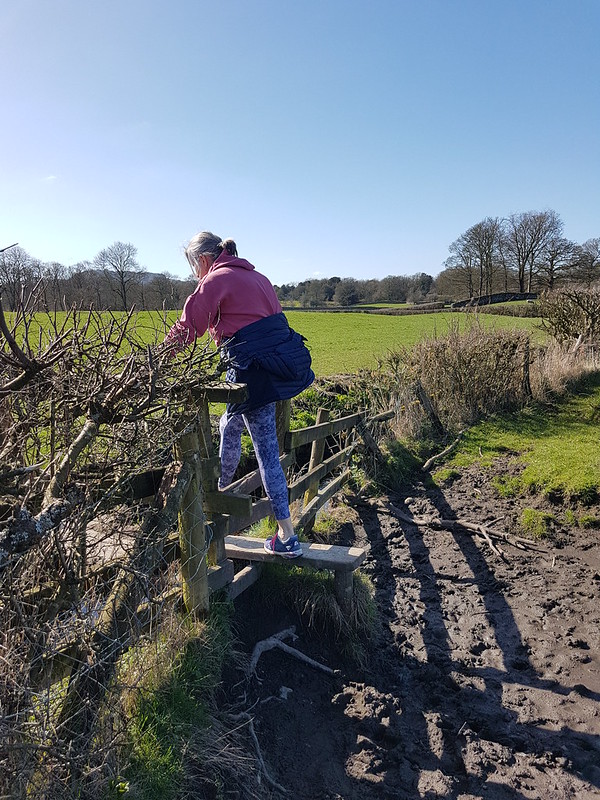


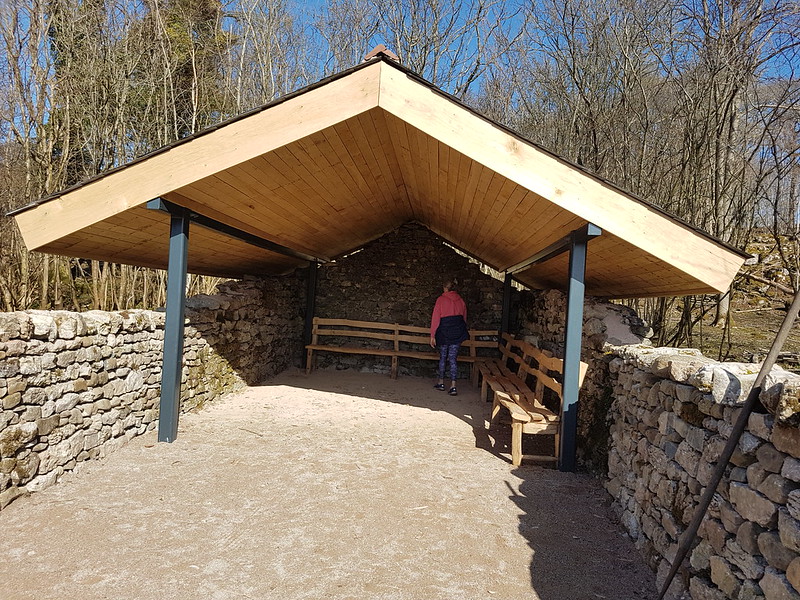
There’s a smart new structure in the National Nature Reserve at Gait Barrows – I’m not sure what the intended uses will be. I can see myself maybe pausing here for a cup of tea from time to time.

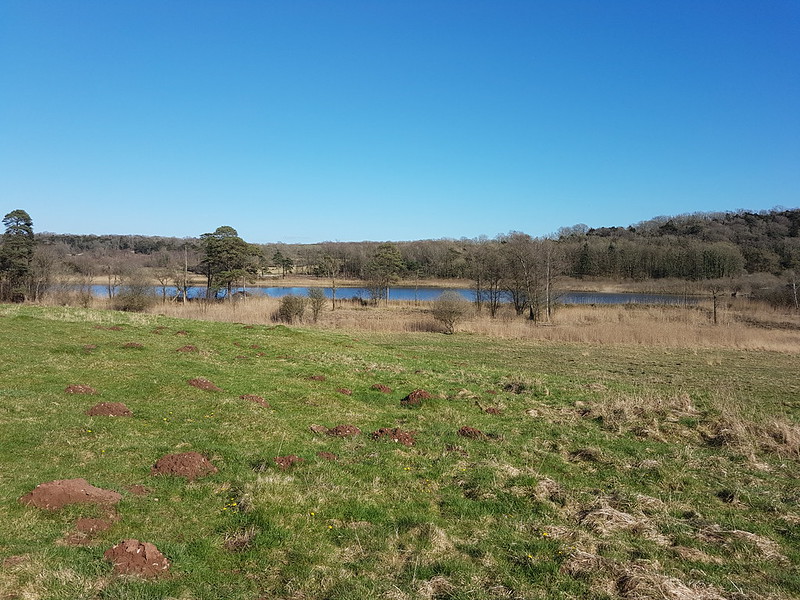
By the end of our walk, all the clouds had gone; quite a contrast with the earlier. So, typically British predictably unpredictable weather!
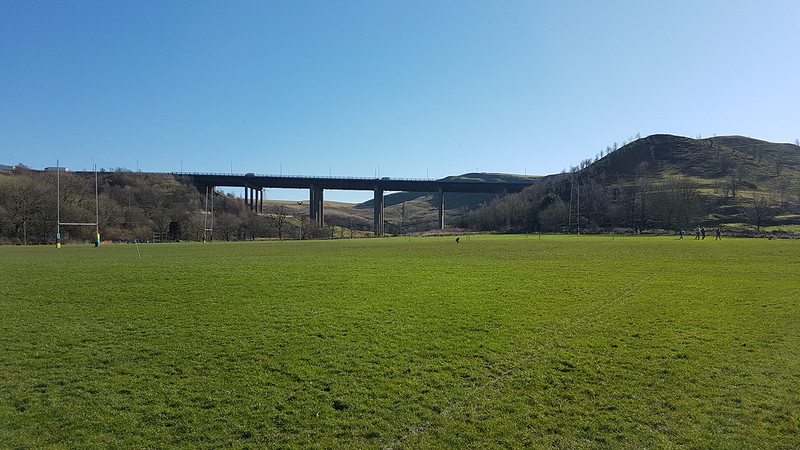
When we used to drive to Cockermouth or Penrith or Giggleswick or Grassington for B’s rugby matches, I thought that it was sometimes a bit far to go for a game – your average local football league, for instance, would have plenty of teams within spitting distance, but rugby seems to be a bit different. Now, however, the fixtures are nearly always even further afield, so it’s good that the club provide a coach.
This fixture was at Littleborough, which is appended to the north-east of Rochdale, which is, in turn, appended to the north-east of Manchester. To get to the ground we’d driven around Hollingworth Lake, which on this gloriously sunny February Sunday was thronged with day-trippers. The coach driver had done a sterling job getting along the very minor road and especially across an awkward bridge into the car-park.
The team always need to be there early, for phsyio and strapping, a warm up, presumably a team talk, so there’s always time to kill before kick-off. I try to get out for a wander if I can.
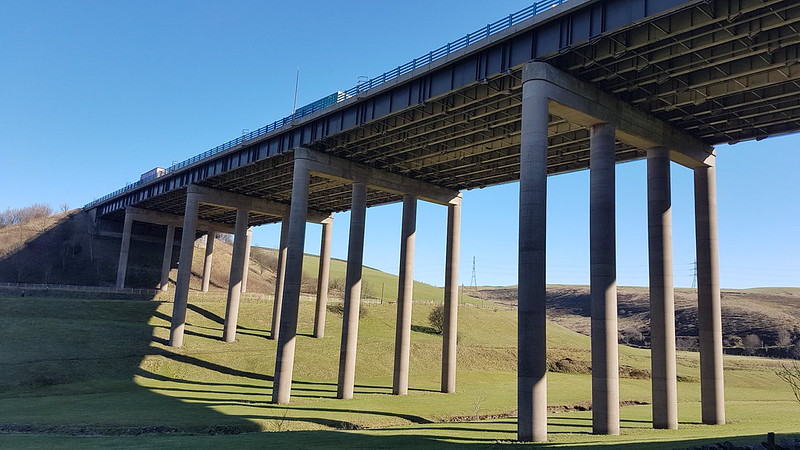

Once under the motorway, I climbed alongside Dick Hill until I met a track which sloped back down into the valley.
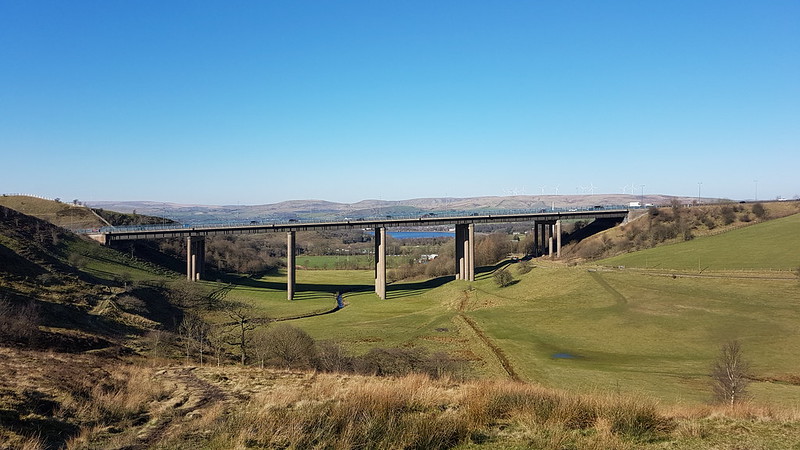
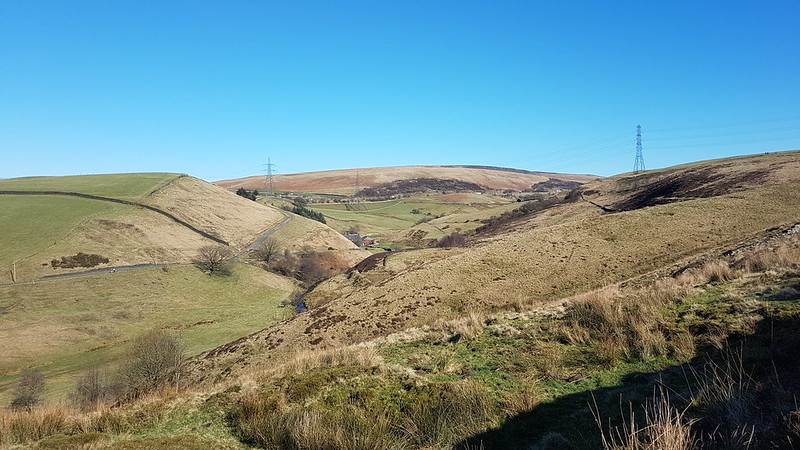
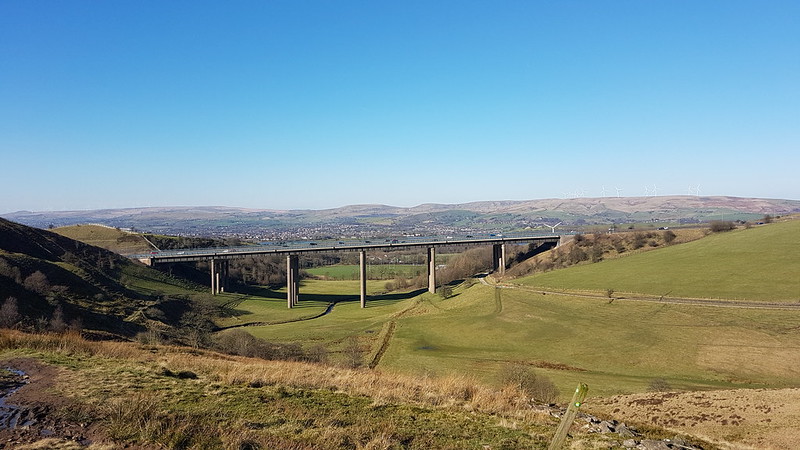
The area is criss-crossed by paths (including one right through the pitches at the rugby club!) There were lots of people out walking, running or cycling. The bridge looked very handsome, the pennine hills and valleys looked very handsome, it was all rather lovely. I think the sunshine helped a lot!

Blackstone Edge, on the Pennine Way, is nearby and I’d hoped we would get to Littleborough early enough for me to get up there for a nostalgic visit, but it wasn’t to be. Never mind, I enjoyed my short stroll immensely.


And the match? The lads won again, which took them one step closer to winning the league.
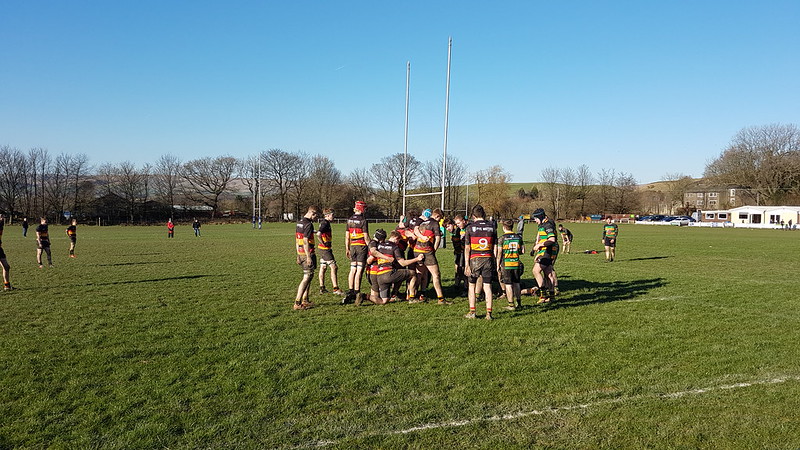
That’s B, about to pack down at tight-head (Kirkby are in the red, black and yellow). Like walking, watching rugby is much more pleasant when the sun shines!

We have New Neighbours. Well, not that new – they moved in, most of them at least, last winter, just before the lockdown started. Happily, our New Neighbours are also Old Friends, G and BB and their kids, who have appeared on this blog from time to time. It has been a hard year for them. Aside from the stress of moving house, getting lots of work done on the house, the lockdown etc – during which one member of the family was ‘stranded’ at her Grandparents (and spoiled rotten, no doubt), they’ve had the virus, twice in some cases, and had to postpone their wedding.
Sitting around a blazing fire in one of our respective gardens, with our neighbours and another family from across the road, has often been the sum total of our social life this year. And thank goodness we’ve had that at least.
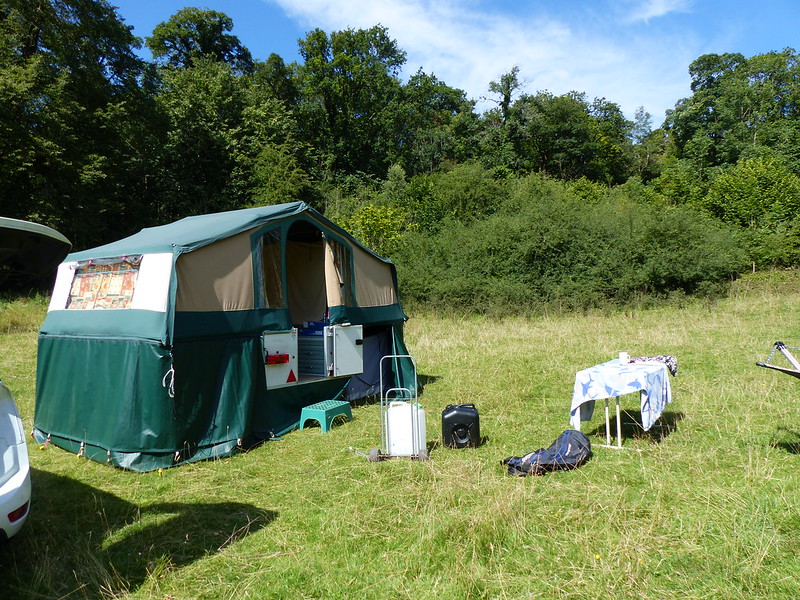
Anyway, in the summer, they modified their holiday plans and booked a long weekend at Silver Sapling, the local Girl Guide campsite, which is about half a mile from home (G is on the management committee) and invited us to join them.

It probably sounds like a crazy idea, to camp just down the road from home, but, well, it was a fantastic weekend. The weather was scorching. Our neighbours had bought a paddling pool especially and sitting in the freezing water and chinwagging seemed to keep the teenage faction happy for hours on end, even in the evenings when it turned very cool. I remember doing a fair bit of reading, some walks with TBH, and a lot of nattering.
Somebody had been hacking back the brambles and there were piles of dried briars heaped up in various places around the site. BB and I gathered them all up – prickly work – and then lit them, they took a little while to catch, but then flared up into a towering conflagration which was highly entertaining, if a little alarming.


Small Tortoiseshells.
The day after my ascent of Clougha and A has another lesson. It was even hotter than the day before and I opted for a level walk in the Lune valley. I originally planned to park at Crook O’Lune, but it was heaving, so plan B was to start from the Bull Beck car park near Brookhouse.
I followed a simple loop along the Lune and then finished along the old railway line, the Lune Valley Ramble, from Crook O’Lune.
The Lune and Aughton Woods.
This spot, with a nice view along the valley to Ingleborough and a mile from the car park, would be a good place for a socially-distanced swim. Another time.
A juvenile Oystercatcher with parent.
Waterworks Bridge – carrying water from Haweswater to Manchester.
A pair of Goosanders – I think a female and a male in eclipse plumage.
I was a bit confused by this umbellifer which had a very large flower and thick stem.
I think it must be common-or-garden Hogweed; I didn’t think the leaves were right, but apparently they are very variable in shape.
This little footbridge crosses…
…Bull Beck, another tributary for my Lune Catchment collection.
You can’t really tell from the photograph, but as I got close to Crook O’Lune both the river and its banks got very busy; plenty of people were enjoying the heat and the sunshine.
I’d faffed about finding a place to park and then dawdled taking photos on a walk which I had significantly underestimated. I was even later getting back into Lancaster to pick-up A. Fortunately, she’d found a bench to sit on in the sunshine and seemed quite sanguine about my tardiness.
Tunes, and a quiz:
Three brilliant tunes – what links them?
The River Bela and Whitbarrow Scar.
After our swim, A had to get home, I forget why now, but I was in no hurry, so asked TBH to drop me off in Milnthorpe, so that I could walk back. I followed the River Bela through Dallam Deer Park and out towards it’s confluence with the Kent. The path then picks up the embankment of the old Arnside branch line, rejoining the road near the ‘orchid triangle’ at Sandside, a small section of roadside verge renowned for the orchids which appear there, not that I could find any on this occasion.
Common Blue butterfly on unopened Oxeye Daisy.
Oxeye Daisy.
Bird’s-foot Trefoil.
When I photographed this flower, I didn’t photograph the leaves; I suspect that I was confident that I knew what I was looking at and, probably, that this was Common Bistort. However, the rounded flower looks more like Amphibious Bistort, a curious plant in that it has two different forms – one adapted to grow on land and the other which grows in water.
After a lengthy period of dereliction, the Quarry Warehouse was restored as offices several years ago. It stands next to an enormous double limekiln and I wondered whether its presence here was due to the Furness railway line which came right past, but apparently it substantially predates the railway line…
The earliest reference to the warehouse is in a document from 1778 in the form of a lease for 99 years from Daniel Wilson to John Wakefield of Kendal, a shearmandyer. The document is for the lease of a warehouse at Sandside for ‘£5 15s and 10d yearly’. John Wakefield was listed in Bailey’s Northern Directory (1781) as a merchant and manufacturer, and again in 1790 ‘Wakefield, John and Sons’ were still listed as merchants in Milnthorpe.
It’s amazing what a little lazy internet research can throw up isn’t it? I was intrigued by the word ‘shearmandyer’: another search led to lots of references to former residents of Kendal, so perhaps it was a very local term. I presume it refers to someone involved in the wool trade. John Wakefield has a short wikipedia entry. He was quite the entrepreneur: he owned a cotton mill in Burneside, a brewery in Kendal, set-up a bank, invested in a turnpike and owned five ships trading between Liverpool and the West Indies, taking Kendal cotton out and returning with sugar. Strange to think that the cotton was almost returning to where it had presumably come from. He also ran the Gatebeck Gunpowder Mill near Endmoor, for which he was censured at a meeting of his fellow Kendal Quakers.
Milnthorpe itself was once a port, which seems very unlikely now, but the building of the railway viaduct significantly changed the estuary. The Quarry Warehouse apparently once had its own wharf.
Anyway, back to my walk, I’d come this way to try to find a path around the western edge of Sandside Quarry, which Conrad had written about. This is it…
I was very pleased to find a route close to home which I’d never walked before.
Yellow Pimpernel.
Sandside Quarry. Still a working quarry, unlike the many others in the area.
Limestone pavement.
I had intended to go to the top of Haverbrack to enjoy the splendid view of the estuary from there, but it now occurred to me that I still had quiet a way to go and that it was hot and I didn’t have a drink with me, again, so I decided to head fairly directly home via Beetham Fell and its Fairy Steps…
…down to Hazelslack Farm and then along the side of Silverdale Moss to Hawes Water and home from there.
Buzzard.
Painted Lady – I haven’t seen many this year so far, after a bumper summer last year.
On the verge of the lane from Hazelslack Farm I enjoyed this mixture of Crosswort and Forget-me-nots. I was confused by the white flowers in amongst the blue until I realised that they too were Forget-me-nots which had faded in the sun.
I think that this is a Mistle Thrush, rather than a Song Thrush, but that’s because of the ‘jizz’ of the bird on the day rather than anything specific I can pick out on this photo.
Squirrel in the woods near Hawes Water.
Morecambe Bay, with lots of horseshoe vetch rather imperfectly captured in the foreground.
When I was at secondary school, in my mid-teens, I spent my lunchtimes playing cards, or football; listening to, or later, a sixth-form privilege, playing records in the music club, which is the only time I remember ever being in the school’s one and only lecture theatre; bunking off into town to borrow books or records from the library, or occasionally buying records; even more infrequently going to the pub with friends for a sneaky beer (way under-age and in uniform, how times have changed); but sometimes, quite frequently to be honest, I would slope off to the school’s library for a quiet half-hour. I’ve always been a bookworm. Back then, I liked to read New Scientist each week, and sometimes leaf through the English edition of Pravda, because it tickled me that the school bought it, and then I had an assortment of favourite books, which I would revisit. There was a dictionary of quotations of which I was very fond; I also remember reading about Russell’s paradox and the paradoxes of Zeno, which could have been in a maths text, but I suspect I more likely discovered them in an encyclopaedia; and there was a coffee-table style book of the photographs of Ansel Adams.
Burnet Rose.
All of which is my long-winded way of introducing the f/64 group and their dedication to pin-sharp photographs, with a huge depth of field, achieved using a very small aperture.
I’m going to guess that these are pollen beetles of some description, the smaller ones anyway.
I was already a photographer, of sorts, by then. My Grandad gave me an old Agfa camera of his own which he’d replaced. It was 35mm, not SLR, but it was necessary, for each photo, to set the aperture and exposure, for which purpose he also gave me a clunky light-meter which was almost as big as the camera. I don’t think I took any very startling photos, limited as I was by the cost of processing the films, but it did give me a great grounding in the mechanics of operating a camera.
Bloody crane’s-bill, I think.
When I finally did get an SLR camera, thanks to my parents largesse, it incorporated a light meter and was semi-automatic. And since the switch over to digital cameras, the couple that I’ve owned seem to have become increasingly autonomous and do everything but choose the subject which is to be photographed, and that’s surely only a matter of time.
Bell heather, I think.
I do switch off the full automatic mode when I’m using the telephoto for nature shots of small or distant things.
Wood ant. Small, but not all that small compared to other British ant species.
And I’ve recently remembered that the camera has a ‘landscape’ setting and started using that again, but I need to remind myself how that’s set up. The camera generally defaults to f2.8 because the wide aperture lets plenty of light in which means the huge zoom works better than on many equivalent cameras, but that also decreases the depth of field, which is not ideal for landscape pictures
I’ve also remembered that what captivated me in Ansel Adams black and white photographs, all those years ago, was the sharp detail in the foreground, the distant mountains and even in the clouds. I’ve been trying to remember to include some foreground in the pictures, maybe by kneeling or lying down or by finding something striking to frame in the foreground.
This picture, for example, of Grange and Hampsfell, could really do with a bit more interest in the foreground. To be fair, the reason I took it was to show the channel, which was no longer right under the cliffs and which seems to be connected to the River Kent, which is how the OS map shows it.
These two, with a bit thrift for colour, are what I was thinking of, although how successful they are I’m not sure.
It kept me entertained, thinking about it, anyway.
Oystercatchers.
The f/64 photographers were based in California and had all of the advantages that offers in terms of scenery and particularly in terms of light. Even in the good spell of weather we’ve had, you can’t always guarantee decent light in the North-Wet of England.
The pictures, long-suffering readers will almost certainly recognise, were taken on a walk around the coast to Arnside, which was followed with a return over the Knott, creature of habit that I am.
New Barns and Arnside Knott.
Close to Arnside, where there’s a small public garden abutting the estuary, there was a real hullabaloo in the tall pines growing in the garden. The noise was emanating from a conspiracy of ravens, some of which were in the trees and some of which were circling above, clearly agitated. This single individual was holding itself aloof from the fuss, coolly going about its business.
It eventually flew up on to the wall and then proceeded to hop and prance about there, looking, I thought, very pleased with itself, like a mischievous and slightly disreputable uncle enjoying a fag outside, whilst the family party audibly descends into a squabble within.
Train crossing the Kent viaduct.
Arnside.
From the end of the promenade, I climbed up through the old Ashmeadow estate where there a small area of allotments. There something very comforting about a well tended allotment, I always think, not that I’d ever have the patience to keep one neat and tidy myself.
From there I was up onto Redhill Pasture, where, any day now, I should be able to assist with the wildflower monitoring project again; we’ve just had the go ahead from our local National Trust officer.
Redhill Pasture.
Lakeland Fells from Redhill Pasture.
Kent Estuary from Redhill Pasture.
Kent Estuary from Redhill Pasture, again.
Forest of Bowland and Arnside Tower from the south side of the top.
Morecambe Bay from the south side of the top.
Goldfinch – there were several together on this telephone line.
Through a bit of sleight of hand, I can finish with a sunset, although, in truth, these photographs are from the evening before the rest of the photos. I had a late walk on the sands and then found a sneaky way up on to Know Hill.
It wasn’t a great sunset, but I like the different perspective the slight gain of height gives and the view of the Coniston Fells beyond the Bay.
I shall have to try this again sometime.
Today’s tunes all can only really be things I can remember playing when it was my turn on the decks during the rather subdued disco with nowhere to dance, in the lecture theatre, which I think was a weekly affair. To set the scene, most of my contemporaries would play tunes from Michael Jackson’s ‘Thriller’ album with an admixture of The Thompson Twins and, bizarrely, Thomas Dolby. As we progressed through the sixth-form I guess you could add The Smiths and U2 to that list.
There was a very vocal and fairly large minority of headbangers, or grebs, as we called them, who felt that music began and ended with Status Quo, Iron Maiden, Whitesnake and the like.
And then there was me and my mate A.S. It’s not that I didn’t like what my other friends played; mostly I did, but they all played the same things. The sixth-form committee had a pretty vast and reasonably varied collection of 45s, why not dip into it?
‘Babylon’s Burning’ The Ruts
‘Echo Beach’ Martha and the Muffins
‘Nut Rock’ Bumble Bee and the Stingers
‘Saturday Night at the Movies’ The Drifters
Also, always the Tommy Opposite, I knew full well that some of my choices really got up peoples noses. We did sixth-form parties too, and rented ourselves out, mostly for eighteenth birthday parties. We were very cheap, but you might find as many as 10 thirsty DJs arriving with the PA and the lights. Happy times.